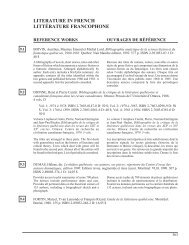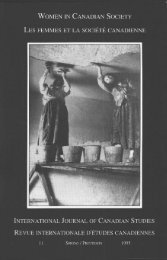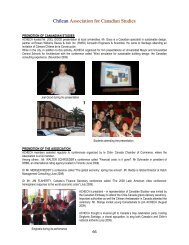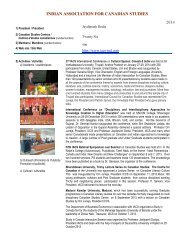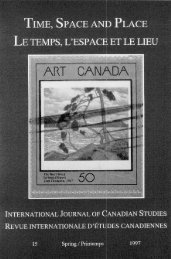Arts and Literature in Canada:Views from Abroad, Les arts et la ...
Arts and Literature in Canada:Views from Abroad, Les arts et la ...
Arts and Literature in Canada:Views from Abroad, Les arts et la ...
- No tags were found...
Create successful ePaper yourself
Turn your PDF publications into a flip-book with our unique Google optimized e-Paper software.
IJCS/RIÉCTrail through the cañon, <strong>and</strong> the mounta<strong>in</strong> streamSounds his sonorous music far belowIn the deep-wooded w<strong>in</strong>d-enchanted clove.Hemlock <strong>and</strong> aspen, chestnut, beech, <strong>and</strong> firGo tier<strong>in</strong>g down <strong>from</strong> storm-worn crest <strong>and</strong> ledge,While <strong>in</strong> the hollows of the dark rav<strong>in</strong>eSee the red road emerge, then disappearTowards the wide p<strong>la</strong><strong>in</strong> <strong>and</strong> fertile valley l<strong>and</strong>s.My forest cab<strong>in</strong> half-way up the glenIs solitary ...These <strong>la</strong>st l<strong>in</strong>es are remarkably precise about the location of the persona'sviewpo<strong>in</strong>t: he is <strong>in</strong> a position that allows him to survey the scenery, but thisspot is only “half-way up the glen.” It seems important for the persona'sl<strong>and</strong>scape experience that he is not too far above the l<strong>and</strong>scape to be aware ofits refuge as well as its prospect potential. In fact, the enumeration of thevarious forest trees that might provide refuge is noteworthy, <strong>and</strong> the viewpo<strong>in</strong>titself features a prom<strong>in</strong>ent element of shelter—the persona's cab<strong>in</strong>.In contrast to the panoramic view, objects seen <strong>from</strong> a low angle appear totower <strong>and</strong> overwhelm the spectator, <strong>and</strong> this perspective is thus appropriate tothe presentation of l<strong>and</strong>scapes encountered with fear. McGregor (1985)observes the 19th-century Canadian artist's preference for pa<strong>in</strong>t<strong>in</strong>g waterfalls<strong>from</strong> exactly such an angle of vision—or to impute it to characters <strong>in</strong> thepicture:... waterfalls are typically seen <strong>from</strong> below <strong>and</strong> at re<strong>la</strong>tively shortrange. The human figures, usually dim<strong>in</strong>utive <strong>and</strong> almost alwaysp<strong>la</strong>ced at or near the base of the falls, often seem to be trapped <strong>in</strong> thebottom of a deep bowl, <strong>and</strong> although the viewer usually looks downon these figures (dim<strong>in</strong>ish<strong>in</strong>g them even further), we share theirperspective <strong>in</strong> look<strong>in</strong>g up at the falls. (19)Joseph Howe's Acadia (1874) provides a po<strong>et</strong>ic parallel to this use ofperspective, <strong>and</strong> here, too, an <strong>in</strong>timidat<strong>in</strong>g effect is unmistakable:There might you st<strong>and</strong>, beside that fall<strong>in</strong>g stream,Nor ought of man or of his do<strong>in</strong>gs dream;While high above you towers the rifted rock,Crowned by old groves, unscathed by tempest's shockAs <strong>from</strong> the steep its fall<strong>in</strong>g waters spr<strong>in</strong>gAnd at your fe<strong>et</strong> their broken foam-wreaths fl<strong>in</strong>g.12



